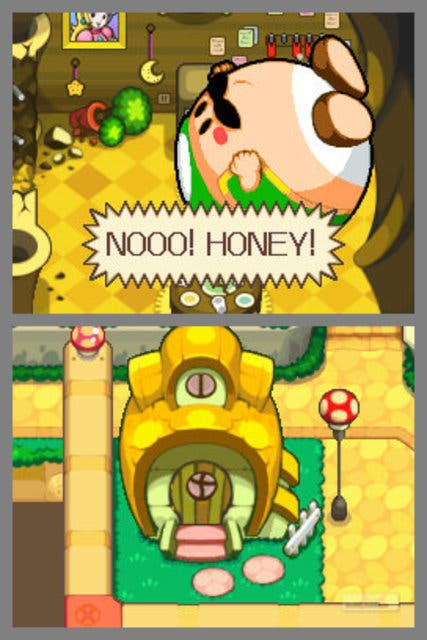Mario & Luigi: Bowser's Inside Story
Gutsy.
Bowser's adventure is quite different in execution to Mario and Luigi's sections of the game, presenting a top-down, 16-bit Zelda-style view on the action that sees you smashing your way through rocks and uprooting trees as you move from place to place. Players who disliked switching between characters so regularly in Partners in Time will be pleased to hear that you control each character for a good 30 minutes before having to switch to the other squad.
As with the previous titles in the series the game bursts with bright Nintendo creativity, occasionally even offering you the chance to play from Giant Bowser's point of view - holding the DS sideways while using the stylus to punch and blow into the microphone to burn enemies with fire.
The mini-game suites included with the game encourage the perfection of in game-techniques for high scores. Here you'll be trying your hand at endurance challenges, seeing how long you can keep a special attack going by timing inputs or, alternatively, seeing how many metres you can bounce Mario along the road by positioning Luigi's head-mounted trampoline.
Similarly, Bowser's mini-games have you seeing how many times you can attack Broque Madame with your special attack, racing to touch the Goombas that appear on screen in time to set them on fire and send them scuttling off to explode in her backside. Another mini-game has you sliding Bowser up and down the screen like a misshapen Pong paddle in order to repel Koopa shells, while yet another has you lining up Bob-ombs with the stylus before they race off in a straight line to blow up their targets.

It's lighthearted and executed with exactly the sort of charm and humour you'd expect of the growing spin-off series. The English language sections of the game we had time with make clear that Nintendo's localisation department is, as ever, doing fine work ensuring both the character and comedy translates seamlessly from the original Japanese. Indeed, as with so much of their work, the text is so measured and its jokes so relevant that it's almost impossible to tell that the script wasn't originally written for an English-speaking Western audience.
Alongside the Paper Mario games, Mario and Luigi's handheld RPG outings are singular in their design and approach to one of Japan's eldest and least flexible genres. The core building blocks are similar: experience points, turn-based battles, character leveling and exploration all key elements.
But their application, presentation and context is like nothing else in the Japanese RPG oeuvre, both broadening and challenging its audience with its bold reworking of convention. In Bowser's Inside Story, Mario may have found his most unusual context yet, a singular premise that may prove the game's biggest opponent to success; as Bowser boldly demonstrates, so often our enemy lies within.

